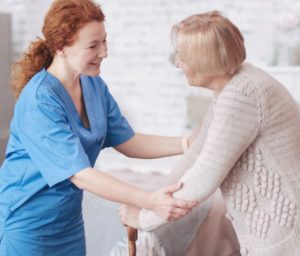 Multiple factors increase an older adult’s risk for falls, including gait and balance disorders. While your manner of walking changes with age, certain symptoms may be related to a chronic health condition and can compromise mobility.
Multiple factors increase an older adult’s risk for falls, including gait and balance disorders. While your manner of walking changes with age, certain symptoms may be related to a chronic health condition and can compromise mobility.
For you or an aging loved one, here’s what you should know.
Understanding Gait and Age
Gait is related to mobility, including how well you walk and move around. Issues can affect how well you stand, turn, get up from a seated position and perform activities of daily living.
Gait disorders influence speed, synchronicity and coordination of movement, yet are not an inevitable consequence of aging. While age can result in smaller strides and the need for more support, natural gait changes include:
- Moving at a slower pace
- Having to keep both feet on the ground to remain stable
- Decreased calf muscle strength
- Postural changes, due to weakening abdominal muscles
- Lesser pelvic and joint motion
Despite these changes, cadence – the rhythm at which a person walks – remains unchanged with age.
Causes of Gait Disorders
Gait disorders may be temporary or permanent. A temporary change may result from an injury, inflammation or pain, while permanent issues often stem from muscular, neurological and joint changes or degenerative disorders. This condition may arise due to:
- Spinal stenosis
- Dementia
- A movement disorder
- Neuropathy
- Arthritis
- Inner ear disorders
- A stroke
- Multiple sclerosis
- Meniere’s disease
- Parkinson’s disease
- Cerebral palsy
- Spinal cord compression
- Obesity
- Vertigo
- Gout
- A brain tumor
- Vitamin B-12 deficiency
- A foot injury
Gait changes can also be related to poorly fitting or insufficient footwear.
Signs of a Gait Disorder
Gait disorders are common in older adults and risk increases with age. An estimated 15 percent of people over 60 have a gait disorder and this increases to about 82 percent by 85.
Men are more likely to develop this condition through neurological degeneration while for women, these disorders tend to arise from joint and other bodily changes. About one-third of all older adults in assisted living communities have a gait issue.
Common symptoms include:
- Decreased symmetry between the left and right sides, including step length and how joints move in sync
- Challenges initiating movements and staying in motion; a leg or foot may appear frozen
- Foot or toe dragging
- Appearing to move backward
- Seeming to fall while walking or leaning forward
- Leaning toward the side
- Shorter or faster steps
- Spending more time standing in one place
- A wider stance while moving
- Legs and feet don’t move in a straight line
- A less stable or poorly aligned torso
- Excessive or a lack of arm movement
Assessing and Diagnosing Gait Disorders
When you visit a doctor, you’ll undergo a mobility assessment and other clinical tests to examine physical and neurological changes. Your movements without an assistive device will also be assessed. After telling the doctor your concerns about mobility:
- You may be asked about balance, walking and falling issues and how well you can climb stairs, get into a bath tub and complete other ADLs.
- Your medical history will be reviewed, including any chronic conditions and musculoskeletal disorders.
- Expect to undergo neurological, musculoskeletal and various gait assessments. You’ll be timed as you move a certain distance without an assistive device and your lower body strength and balance will be examined.
- Your cadence, step length and step height will also be evaluated to determine if you fall outside the normal range for your age. These tests can determine if your rhythm is off or your limbs and joints are not moving together.
- Due to neurological factors, a CT scan or MRI may be done if your gait displays stiffness, irregularity or periodic stops.
Based on your results, treatment for a gait disorder can include:
- Physical therapy, with emphasis on strengthening and balance exercises
- Using an assistive device, like a walker or cane
- Adjusting your movements in response to body changes
If you’ve noticed signs of a gait disorder, the medical professionals at Avon Health Center can help. To learn more, contact us today.

